
Alexanderplatz is a large public square and transport hub in the central Mitte district of Berlin. The square is named after the Russian Tsar Alexander I, which also denotes the larger neighbourhood stretching from Mollstraße in the north-east to Spandauer Straße and the Rotes Rathaus in the south-west.
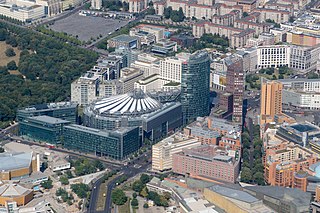
Potsdamer Platz is a public square and traffic intersection in the center of Berlin, Germany, lying about 1 km (1,100 yd) south of the Brandenburg Gate and the Reichstag, and close to the southeast corner of the Tiergarten park. It is named after the city of Potsdam, some 25 km (16 mi) to the south west, and marks the point where the old road from Potsdam passed through the city wall of Berlin at the Potsdam Gate. Initially, the open area near the city gate was used for military drills and parades. In the 19th into the 20th century, it developed from an intersection of suburban thoroughfares into the most bustling traffic intersection in Europe. The area was totally destroyed during World War II and then left desolate during the Cold War era when the Berlin Wall bisected its location. Since German reunification, Potsdamer Platz has been the site of major redevelopment projects.

Welthauptstadt Germania or World Capital Germania was the projected renewal of the German capital Berlin during the Nazi period, part of Adolf Hitler's vision for the future of Nazi Germany after the planned victory in World War II. It was to be the capital of his planned "Greater Germanic Reich". Albert Speer, the "first architect of the Third Reich", produced many of the plans for the rebuilt city in his capacity as overseer of the project, only a small portion of which was realised between the years 1938 and 1943.
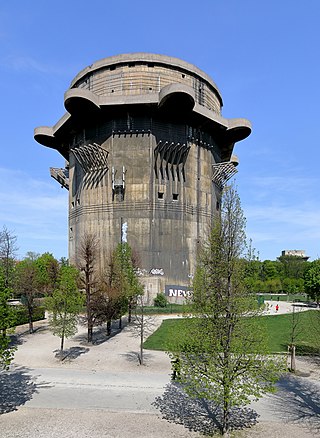
Flak towers were large, above-ground, anti-aircraft gun blockhouse towers constructed by Nazi Germany. There were a total of 8 flak tower complexes in the cities of Berlin (three), Hamburg (two), and Vienna (three) from 1940 onwards. Other cities that used flak towers included Stuttgart and Frankfurt. Smaller single-purpose flak towers were built at key outlying German strongpoints, such as at Angers in France, and Heligoland in Germany.

The Kroll Opera House in Berlin, Germany, was in the Tiergarten district on the western edge of the Königsplatz square, facing the Reichstag building. It was built in 1844 as an entertainment venue for the restaurant owner Joseph Kroll, and redeveloped as an opera house in 1851. It also served as the assembly hall of the Reichstag from 1933 to 1942. Severely damaged by the bombing of Berlin in World War II and the Battle of Berlin, it was demolished in 1951.
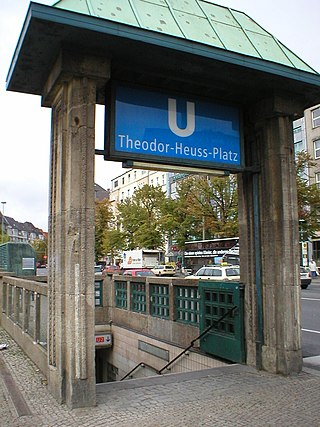
Theodor-Heuss-Platz is a station on line U2 of the Berlin U-Bahn, located in the Westend district.

Rosa-Luxemburg-Platz, formerly the Bülowplatz, is a square in Berlin-Mitte, Germany.

Jungfernstieg is an underground railway station in the city centre of Hamburg, Germany, served by the underground railway (U-Bahn) and the suburban railway (S-Bahn). The station is one of Hamburg's busiest rapid transit hubs.

Haidhausen is a quarter of Munich, Germany. It is now part of the borough—or stadtbezirk—number 5 Au-Haidhausen.

Theodor-Heuss-Platz is a large city square in the Westend district of Berlin, Germany. It is named after Theodor Heuss (1884–1963), the first President of Germany after World War II.
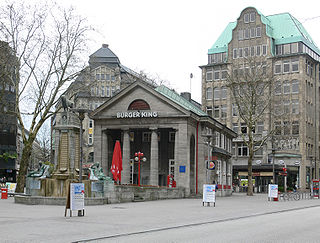
The Mönckebergstraße is one of the main shopping streets in Hamburg, Germany.
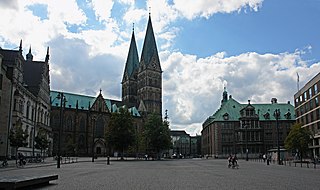
The Domshof is a town square in Bremen, north of the cathedral and the Marktplatz. The Domshof is used for markets as well as larger outdoor events, particularly May Day demonstrations.

The Jungfernstieg is an urban promenade in Hamburg, Germany. It is the city's foremost boulevard.

The Kaiser-Joseph-Straße in Freiburg im Breisgau is a shopping street of about 900 meters, which runs through the center of Freiburg's historic downtown from north to south. It is one of the most expensive locations in Germany.

Altstadt, more precisely Hamburg-Altstadt – as not to be mistaken with Hamburg-Altona-Altstadt – is one of the inner-city districts of the Free and Hanseatic City of Hamburg, Germany.

Neustadt is one of the inner-city districts of the Free and Hanseatic City of Hamburg, Germany.

Hans-Albers-Platz is a square in St. Pauli, Hamburg, Germany. It is one of the most popular places and tourist attractions within the red light district south of the famous street of Reeperbahn. It is named after the actor and singer Hans Albers.

Gerhart-Hauptmann-Platz is a central square in Altstadt quarter, Hamburg, Germany. The former Pferdemarkt is located at the junction of the streets of Mönckebergstraße, Spitalerstraße and Alstertor. The southern part of the square was renamed into Ida-Ehre-Platz on 9 July 2000, in honour of the actress and intendant of Hamburger Kammerspiele.

The Platz der Alten Synagoge is a square in Freiburg, Germany. With a size of 130 square metres, it is the second largest square in the city after Minster Square. The square is named after the old synagogue, which was destroyed during the Kristallnacht in 1938. The synagogue had been built in 1869/1870 to the southwest of today's location of the square.





















